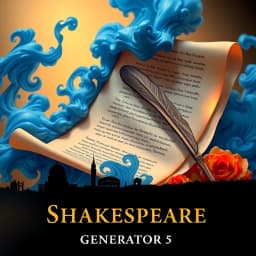
Shakespeare Quote Generator 5
Find this useful? Bookmark ( CTRL/CMD + D ) for quick access!
Try an example:
Inspirational Quotes
Romantic Lines
Humorous Sayings
Dramatic Monologues
Literary Analysis Prompts
Themed Social Media Posts
Explore Similar Tools
Recent Generations
the amount paid directly to you. Yes it is possible in future cases to request direct payment to the provider, Rephrase and give me polished email.
we have processed the claim as per the attachments in the claim submission we have processedthe invoice for Saul Holding. We dont have invoice for the Salofalk.
this additional information is very important. this adiitional information was requested by our clinical team. Without clinical review claim not be paid so please share the below additional information
Shakespeare Quote Generator 5
Shakespeare Quote Generator 5 is a powerful AI-powered tool that helps users effortlessly discover and share quotes from the legendary playwright William Shakespeare. This innovative solution combines advanced natural language processing with a vast database of Shakespearean texts to deliver authentic and contextually relevant quotes for any occasion.
Key Capabilities
- Instant Quote Generation with a simple click, providing users with a diverse selection of Shakespeare's most memorable lines.
- Contextual Search Functionality enabling users to find quotes based on themes, characters, or specific plays, making it easier to find the perfect quote for any situation.
- User-Friendly Interface for seamless navigation, allowing both seasoned Shakespeare enthusiasts and newcomers to explore quotes without any hassle.
- Shareable Content that allows users to easily share quotes on social media platforms, enhancing engagement and connection with fellow literature lovers.
Who It's For
Designed for literature enthusiasts, educators, and social media influencers, Shakespeare Quote Generator 5 excels in providing inspiration and insight. Whether you're preparing for a class discussion, crafting a social media post, or simply looking to enrich your vocabulary, this tool streamlines your search for the perfect Shakespearean quote.
Why Choose Shakespeare Quote Generator 5
What sets Shakespeare Quote Generator 5 apart is its extensive database and intelligent search capabilities, making it the ideal solution for anyone seeking to explore the timeless wisdom of Shakespeare. With this tool, you can easily find quotes that resonate with your audience and enhance your literary projects.
Ready to transform your literary experience? Start using Shakespeare Quote Generator 5 today and immerse yourself in the world of Shakespearean brilliance!
Enhance Your Work with Shakespeare Quote Generator 5
Leverage the power of AI to streamline your tasks with our Shakespeare Quote Generator 5 tool.
Randomized Quotes
Generate a wide variety of Shakespeare quotes at random, perfect for inspiration or entertainment.
Thematic Search
Search for quotes based on themes, characters, or plays, allowing for targeted exploration of Shakespeare's work.
Easy Sharing
Quickly share your favorite quotes on social media or via messaging apps with just a click.
How Shakespeare Quote Generator 5 Works
Discover the simple process of using Shakespeare Quote Generator 5 to improve your workflow:
Select a Theme
Choose a theme or topic for the quotes you want to generate.
Generate Quotes
Click the generate button to create a selection of Shakespeare quotes based on your chosen theme.
Customize Output
Adjust the settings to customize the style and format of the generated quotes.
Share Your Quotes
Easily share your favorite quotes on social media or save them for later use.
Use Cases of
Shakespeare Quote Generator 5
Explore the various applications of Shakespeare Quote Generator 5 in different scenarios:
Literary Inspiration
Generate Shakespearean quotes to inspire writers and poets seeking to incorporate classic literature into their work.
Social Media Engagement
Create engaging and thought-provoking posts for social media platforms by sharing random Shakespeare quotes to attract followers.
Educational Tool
Assist teachers and students in exploring Shakespeare's themes and language by providing relevant quotes for discussions and assignments.
Themed Events
Enhance themed parties or events, such as Shakespearean nights, by using quotes to set the mood and spark conversations among guests.
Who Benefits from Shakespeare Quote Generator 5?
AI-Powered Efficiency
From individuals to large organizations, see who can leverage Shakespeare Quote Generator 5 for improved productivity:
Literature Students
Explore and analyze Shakespeare's works through curated quotes for deeper understanding.
Writers and Poets
Find inspiration and enhance creativity by accessing a variety of Shakespearean quotes.
Drama Enthusiasts
Discover iconic lines and themes from Shakespeare's plays to enrich performances and discussions.
Teachers and Educators
Utilize quotes to engage students and facilitate discussions around Shakespeare's impact on literature.
Frequently Asked Questions
What is the Shakespeare Quote Generator 5?
The Shakespeare Quote Generator 5 is an AI tool designed to generate authentic quotes from the works of William Shakespeare, allowing users to explore and utilize his timeless wisdom in various contexts.
How does the quote generation process work?
The tool uses advanced natural language processing algorithms to analyze Shakespeare's texts and generate quotes based on user inputs or themes, ensuring that the quotes are relevant and contextually appropriate.
Can I customize the type of quotes I receive?
Yes, users can specify themes, moods, or specific plays to receive tailored quotes that fit their needs, making the tool versatile for different occasions and purposes.
Is there a limit to how many quotes I can generate?
No, there is no limit to the number of quotes you can generate. Users can create as many quotes as they wish, making it a valuable resource for writers, educators, and enthusiasts alike.
Is the Shakespeare Quote Generator 5 free to use?
The basic version of the Shakespeare Quote Generator 5 is free to use, but there may be premium features available for a fee that offer enhanced functionalities and additional customization options.
































